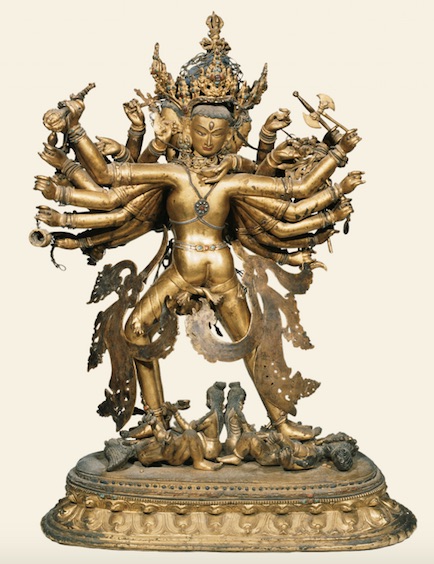15th-16th century, Tibet, Nepalese schools, Kalacakra, gilt copper, 29 cm, photo: courtesy of Ulrich von Schroeder, Buddhist Sculptures in Tibet Volume Two, Visual Dharma Publications, Hong Kong, p. 964 pl. 232A, at the Palkor Chode monastic complex in Gyantse (Tibet).
We have seen very few sculptures of this meditational deity, who has one or four heads and two, four, or twenty-four arms. His name means ‘the wheel of time’ and he is always standing, usually treading on two four-armed Hindu deities often attended by two kneeling female figures (or seated, in this case). The above is in embrace with his consort, Vishvamata, who has four heads and eight arms. He wears a tiger skin loin cloth and a garland of vajra sceptres, she wears a bone apron. They are adorned with crowns and princely jewellery. He holds a vajra sceptre and a vajra bell in his main hands crossed over her back, and a variety of peaceful and wrathful implements in the others (usually an arrow, a hook, a wheel, a spear, a shield, a bow, a lasso, a conch shell, a mirror, a drum, a hammer, a stick, an axe, a ritual staff, a skull cup, a jewel, a lotus, a chain, Brahma’s head).
We saw a larger and earlier Kalachakra with consort, from the Shalu monastery, published on Huntington Archive , the following picture shows the reverse of that statue.
1300-1350 AD, Tibet, Nepalese schools, Kalacakra, gilt copper, 60 cm, photo as before (p. 964 pl. 232B), at the Zhwa lu monastery (Tibet).


